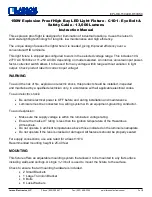
Page
23
Speaker Room Optimization (SRO)
Overview
SRO is a system for measuring the acoustic response of a speaker system and correcting the
speaker system to a target frequency response.
The measurement portion of SRO uses a special noise signal called a maximum length sequence
(MLS). Unlike white or pink noise, MLS signals have unique properties that allow them to be used
to calculate the impulse response, which contains the complete frequency, phase, and time
response of the speaker.
Processing the impulse response with the use of a Fast Fourier Transform (FFT), the frequency
response of the speaker can be calculated and displayed.
Once the speaker frequency response is obtained it can be compared against the desired
frequency response and then the frequency response of the AMC be modified to correct the
speaker response to closer match the target.
The target curve can be an “X” curve, a flat frequency response curve, or an arbitrary curve that
the user created.
To find the combination of filters that best corrects the desired frequency response target, the AMC
control software uses a proprietary genetic mutation algorithm called BOO.
BOO mathematically generates thousands of different EQ settings and determines which one
gives the best match to the target curve. Once BOO picks the best match, the user has the option
of accepting it, or tweaking manually from there.
NOTE:
The SRO program will correct many frequency response problems, but it does have
limitations. It will not give repeatable and reliable results if the room is too noisy or if the room has
too high a reverberation time.
Additional equipment you will need
The Blue Sky SRO program uses an inexpensive USB audio interface and measurement
microphone to generate test tones and measure the frequency response of the speakers attached
to the AMC.
You will need the following:
1) Measurement microphone
- the recommended choices are the Dayton Audio EMM-6 or










































